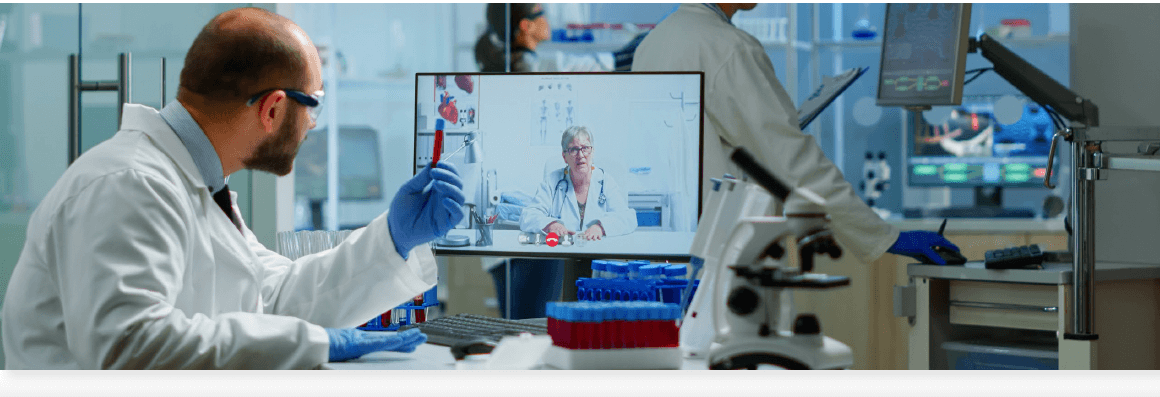Modernizing Regulatory Operations in MedTech: The Key to Global Compliance and Speed to Market
Perspective of Donielle Johnson, VP Global Regulatory Affairs, Bausch Health
The medtech industry is one of the most heavily regulated industries in the world. Now with the rapidly changing regulatory landscape and increasingly complex regulations, it’s more important than ever to have an efficient and scalable regulatory strategy.
The management and execution of regulatory processes have a huge impact on how medical device and diagnostics companies achieve global compliance. With regulatory bodies worldwide updating and enforcing new regulations at an accelerated pace, the need for speed within the regulatory function has never been more critical. This has created an imperative for medtech manufacturers to modernize regulatory processes.
But how exactly can it be done? For Donielle Johnson of Bausch Health, it’s become a personal endeavor. Years after her mother passed away from contracting Hepatitis C during a routine blood transfusion, Donielle has witnessed the significance the life science industry plays on the production and delivery of life-saving products. Living now in a world where Hepatitis C can be treated, helping the industry to bring new, effective, and safer medical devices and diagnostics to the global marketplace is a deep and personal mission for Donielle.
Today, through the perspective of Donielle Johnson, we will explore how regulatory continues to evolve to meet the needs of medical device manufacturers’ quest for compliance, and how forward-thinking global regulatory compliance efforts can help in achieving better speed to market and better outcomes for patients.
Various Stakeholders and Our Missions
Medical devices will become increasingly more important as new technologies allow more people access to life-saving treatments. In the medtech industry, there are numerous stakeholders who are impacted by regulatory activities. From medical device manufacturers to regulatory authorities, all parties have a vested interest in the safe and effective development and commercialization of new devices and diagnostics. However, how each of us achieves this is different because we all have different stakeholders.

“MedTech companies have a responsibility to the shareholders that have invested in the success of their products and services to the industry” explains Donielle. “For regulators, the government is their shareholder who operates to ensure that regulations are enforced in a way that protects the public’s health. Therefore regulators are driven by the laws that are created within their respective countries.”
While there is a difference in primary stakeholders, the patient is at the center of what both medtech companies and regulators exist for. The question is, how do both entities come back together to place the patient and the center and focus on our shared mission?
The Global Regulatory Environment is Rapidly Changing
Companies face a multitude of risks in the global regulatory environment. On top of these risks, the regulatory environment is rapidly changing. Couple this with regulations that are not harmonized across borders and you have a global risk management nightmare.
When thinking about how to help drive harmonization across the medtech industry to improve the quality of care for patients, keeping a close eye on the changing regulatory environment can help companies keep from falling behind.
For example:
- The European market is closely watching developments with EU MDR.
- China’s new 739 rules will affect the Asia market by increasing quality controls while relaxing some clinical requirements.
- Constant changes to ANVISA & INMETRO regulations in Brazil.
- US FDA’s focus on digital health with guidance on robotics, digital health, and software as medical devices.
The constant changing of regulations between these different jurisdictions creates what we call regulatory divergence. The question becomes, how can we find best practices to bring products to market quickly and safely when constantly dealing with regulatory divergence?
Harmonization and Divergence: Where are we going as an industry?
The regulatory compliance issue is compounded by regulatory divergence. This impacts how quickly a product can be brought to market and the quality of care for patients. “How can regulatory compliance happen when regulatory divergence is a factor?” asks Donielle. “How do we solve this problem or at least come up with an answer when there are so many roadblocks in our path? The answer to this question may lie with our shared goal of global regulatory harmonization.”
There are many recent examples of harmonization efforts that are being led by regulatory bodies, including:
- Medical Device Single Audit Program (MDSAP) allows a single regulatory audit of a quality management system to satisfy requirements of multiple regulatory jurisdictions, significantly minimizing the regulatory burden on medical device manufacturers.
- Harmonization by Doing (HBD) harmonizes clinical and regulatory approaches between the United States and Japan which has helped to bring tons of great new technology to market.
- Smaller countries becoming clusters through Eurasian Economic Union (EAEU), Gulf Cooperation Council (GCC), and Asian Harmonization Working Party (AHWP) as additional regulations to harmonize regulatory efforts around the world.
However, as we see harmonization, we also see examples of divergence disrupting global regulatory harmonization, including:
- The withdrawal of the United Kingdom from the European Union through BREXIT
- Switzerland and EU bilateral agreement breakdowns
- EAEU, but Russia and Kazakhastan still expanding and changing regulations
While we keep driving towards harmonization, there are still worldly events that are continuing to promote divergence in the market. So what can we do to drive harmonization?

The Impact on Product Development and Lifecycle Management
One trending challenge that has come to the forefront for regulatory professionals is how deeply regulatory requirements have become embedded in product development and lifecycle management processes. Each phase in this process, from discovery to post-market surveillance, presents new challenges for medtech leaders who are scrambling for alignment among departments with a clear understanding of compliance expectations by regulators as well as cooperative efforts between external stakeholders like manufacturers or healthcare providers.
Current challenges that exist include:
- Increased number of standards and guidance documents
- Managing standards across international markets with unique regulations
- Additional clinical burdens required prior to product launch rather than looking at more real-world evidence in the post-market
- Added responsibilities EU MDR has placed on notified bodies
Donielle shares that “in the coming years with even more regulation, it will take additional time and resources to develop and test products for the global medical devices industry. Not to mention the increased likelihood of being prone to compliance issues.” Medical device companies must act urgently and implement digital regulatory solutions to survive the ever changing regulatory landscape and remain compliant.
How can medtech adapt and stay compliant in a world of rapidlychanging regulations?

One of the best ways for your business to survive these onslaughts is by finding efficiencies within current processes. How?
“By using data differently” explains Donielle. “Feeding information about product lifecycle management directly into innovation cycles might help you build stronger submissions more quickly than ever before. This strategy may also save time during research projects, as predictive analytics and artificial intelligence could allow businesses like yours better organize submission packages compliantly without much hassle at all.”
What will happen if you start trying some new approaches sooner rather than later? You might be shocked by how much you’ll learn about your product portfolio and the rules that govern it. You may even find solutions to current issues, or at least get a better understanding of them so that you can work toward addressing them more effectively in the future.
The medtech industry also needs to increase collaboration across the aisle between AdvaMed, MedTech Europe, and other trade associations that span the globe. Donielle believes that the International Medical Device Regulators Forum (IMDRF) really should be international. It’s in the name, but do we feel like there is a single unified global agenda? We need more partners with real expertise from within our industries who can help shape these agendas into something meaningful for us as end-users. Have we seen any fruits of labor yet or are they still just words on paper?
We must find ways to work with regulators in order to continue surviving and remain compliant. From working hand-in-hand, or even lobbying efforts together, the collaboration will lead us forward into a more sustainable future for our profession through innovative technologies that are safe for patients as well as cost-effective. The IMDRF needs international partners who can share their advice on what has been successful or could be improved upon within different healthcare systems across international borders so we can all grow from each other’s success while also mitigating any risks of failure.
Also, leverage your company capital with lobbyists and other large medical technology organizations in order to incentivize efforts of harmonization driven by government entities that will help keep quality healthcare accessible while creating jobs.

What does the regulatory role of the future look like in medtech?
What does the regulatory role of the future look like in medtech? The regulatory role of the future is not what it used to be. With a shift from an operational responsibility and focus on compliance, regulators can now serve as effective strategic partners in driving innovation and speeding up time-to-market for new products by providing guidance for best practices or standards that could provide quality assurance across industries.
The regulatory field has moved away from its traditional operating model into one where they are now key contributors with input on how businesses should operate their processes if they want them to remain compliant with regulations today and tomorrow.
The future of regulatory affairs seems to be a more strategic, collaborative endeavor. Collaborative partnerships will not just take place internally but also with external partners in order to speed up innovation and the process is shaping regulations instead of simply reacting when they happen.
Regulatory leaders will need to have strong influencing skills in order to shape policy for both internal partnerships with R&D and commercial colleagues if they want their company to reach its goals quicker. The approach should be proactive rather than reactive when it comes to new regulations being instituted because these changes happen so quickly that there might not always even be enough time for reaction.

In the future, we need to have stricter postmarket strategies that will allow for more innovation. This should include collecting real-world evidence and regulating with those findings in mind so as not to stifle any innovative creativity from coming forth.
The regulatory role of the future needs a strong backbone that incorporates rigorous postmarket strategies such as a collection of all available data on an array of factors–including patient safety. These strict policies would help propel medical innovations into existence by paving new ground in predictive risk assessment while at the same time providing adequate oversight against overreach and misuse.
A Modern Future for Regulatory Leaders
As we move forward, it will be important to continue to think about the implications for product development and lifecycle management along with how these changes affect compliance.
The way that medtech companies define, identify, and manage these issues is changing. As a result, the skill sets required of an effective global regulatory leader must evolve in order to keep pace with the industry. With greater access to data analytics and better digital technologies for collaboration, it should be easier to manage these complex challenges across geographies.
Developing the right infrastructure and having good collaboration tools has never been more important. The ability to understand both local and global regulatory requirements is critical. The growing consumer demand for personalized healthcare, changing technology, new ways of providing value, and a dramatically disrupted business model are just some aspects that medtech companies need to consider as they move forward.
Regulatory convergence and divergence will continue to be a key issue as we move forward. Regulators around the world are seeing unprecedented change in a variety of areas impacting product development and lifecycles. Understanding these changes, how they impact compliance, and developing the right infrastructure within companies will help medtech companies become more competitive globally.
As a final reminder from Donielle, thinking of her mother, “if you move forward in your business with the patient as your north star, you will be the kind of change the world is looking for.”